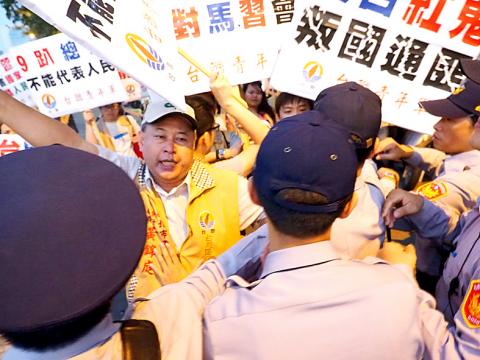A series of protests at several locations in Taipei against the meeting between President Ma Ying-jeou (馬英九) and Chinese President Xi Jinping (習近平) began on Friday night and continued yesterday morning until Ma departed for Singapore at 5:30am.
At about 11pm on Friday night, dozens of people holding up banners advocating Taiwanese independence arrived in front of the Presidential Office Building, accusing Ma of being a “9 percent president” trying to “sell off Taiwan.”
“No to the opaque Ma-Xi meeting, no to concessions on Taiwan’s sovereignty,” the protesters chanted until police officers moved in to remove them, at which the chanting turned into angry yelling and shouting.

Photo: EPA
Both protesters and police officers were injured in a clash between the two sides.
After several waves of clashes, the police lined up behind shields and pushed the protesters away, forcing them to leave Ketagalan Boulevard in front of the Presidential Office Building.
The protesters then headed to the nearby Legislative Yuan, where clashes also broke out and some scaled the front gate of the legislature’s compound.

Photo: EPA
“We are here to voice our opposition to Ma’s meeting with Xi, because his low approval rating shows that Ma has no right to speak for the Taiwanese public,” National Taiwan University student Tien Cheng-hung (田政弘) said. “After the 1992 cross-strait meeting [in Hong Kong], the so-called ‘1992 consensus’ suddenly came into existence. Who knows what will result of the Ma-Xi meeting?”
Following the arrival of reinforcements shortly after 12:30am, an overwhelming number of police began to push demonstrators out of the Legislative Yuan compound, triggering yet another wave of clashes.
Although the compound was cleared out not long after 1am, nearly 200 more people arrived to participate as news of the protest began to spread.
The protesters remained outside the legislature, occupying the right-most lane on Zhongshan N Road and refusing to leave, despite repeated calls by police.
At about 3am, another group of protesters led by Sunflower movement student leader Chen Wei-ting (陳為廷) gathered outside Taipei International Airport (Songshan airport) — where Ma’s flight was scheduled to depart at 5:30am — and tried to force their way into the air force’s Songshan Air Base command building.
Chen and 26 other protesters were quickly arrested by police, and yesterday afternoon were sent to the Taipei District Prosecutors’ Office for questioning.
Citing concern over the possibility of more protests, police later closed off the portion of Minquan E Road in front of the airport.
A third group of protesters mobilized by the Taiwan Solidarity Union (TSU) arrived outside the airport at 5am, planning to hurl shoes and other items at the president’s convoy, but were thwarted after the convoy took a detour.
The protesters then burned a funeral-style portrait of Ma, resulting in the arrest of TSU Department of Youth Affairs director Chang Chao-lin (張兆林).

The US government has signed defense cooperation agreements with Japan and the Philippines to boost the deterrence capabilities of countries in the first island chain, a report by the National Security Bureau (NSB) showed. The main countries on the first island chain include the two nations and Taiwan. The bureau is to present the report at a meeting of the legislature’s Foreign Affairs and National Defense Committee tomorrow. The US military has deployed Typhon missile systems to Japan’s Yamaguchi Prefecture and Zambales province in the Philippines during their joint military exercises. It has also installed NMESIS anti-ship systems in Japan’s Okinawa

‘WIN-WIN’: The Philippines, and central and eastern European countries are important potential drone cooperation partners, Minister of Foreign Affairs Lin Chia-lung said Minister of Foreign Affairs Lin Chia-lung (林佳龍) in an interview published yesterday confirmed that there are joint ventures between Taiwan and Poland in the drone industry. Lin made the remark in an exclusive interview with the Chinese-language Liberty Times (the Taipei Times’ sister paper). The government-backed Taiwan Excellence Drone International Business Opportunities Alliance and the Polish Chamber of Unmanned Systems on Wednesday last week signed a memorandum of understanding in Poland to develop a “non-China” supply chain for drones and work together on key technologies. Asked if Taiwan prioritized Poland among central and eastern European countries in drone collaboration, Lin

Renewed border fighting between Thailand and Cambodia showed no signs of abating yesterday, leaving hundreds of thousands of displaced people in both countries living in strained conditions as more flooded into temporary shelters. Reporters on the Thai side of the border heard sounds of outgoing, indirect fire yesterday. About 400,000 people have been evacuated from affected areas in Thailand and about 700 schools closed while fighting was ongoing in four border provinces, said Thai Rear Admiral Surasant Kongsiri, a spokesman for the military. Cambodia evacuated more than 127,000 villagers and closed hundreds of schools, the Thai Ministry of Defense said. Thailand’s military announced that

CABINET APPROVAL: People seeking assisted reproduction must be assessed to determine whether they would be adequate parents, the planned changes say Proposed amendments to the Assisted Reproduction Act (人工生殖法) advanced yesterday by the Executive Yuan would grant married lesbian couples and single women access to legal assisted reproductive services. The proposed revisions are “based on the fundamental principle of respecting women’s reproductive autonomy,” Cabinet spokesperson Michelle Lee (李慧芝) quoted Vice Premier Cheng Li-chiun (鄭麗君), who presided over a Cabinet meeting earlier yesterday, as saying at the briefing. The draft amendment would be submitted to the legislature for review. The Ministry of Health and Welfare, which proposed the amendments, said that experts on children’s rights, gender equality, law and medicine attended cross-disciplinary meetings, adding that